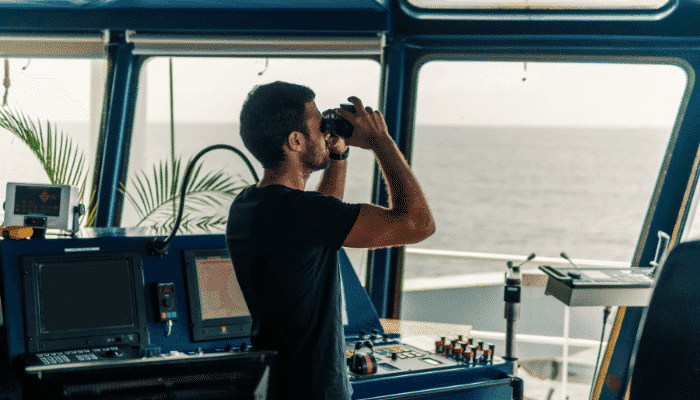What is Bridge Navigational Watch & Alarm System (BNWAS)?
Navigating a giant vessel is not at all an easy job and when it comes to situations of emergency, wherein the navigational officer has to make some quick decisions, the safety of the entire ship and its crew depends on that officer.
This is when automated systems are extremely useful.
BNWAS is one type of automated system used on ships. While the navigation of the ship is probably the most important aspect of delivering the cargo and the crew safely between two points, it must also be understood that the human component attached to navigation is open to errors and faults; with a sudden mishap with respect to the watchkeeper (sudden unavailability due to health reasons while on watch), the ship might be exposed to dangers and the BNWAS assists to tackle such a problem.
What is BNWAS?
Bridge Navigational Watch & Alarm System – BNWAS is a monitoring and Alarm system which notifies other navigational officers or master of the ship if the officer on watch (OOW) does not respond or he/she is incapable of performing the watch duties efficiently, which can lead to maritime accidents.
The purpose of a bridge navigational watch alarm system (BNWAS) is to monitor bridge activity and detect operator disability which could lead to marine accidents.
The system monitors the awareness of the Officer of the Watch (OOW) and automatically alerts the Master or another qualified OOW if for any reason the OOW becomes incapable of performing the OOWís duties. This is achieved through a mix of alarms and indications which alert backup OOWs as well as the Master.
BNWAS warnings are given in the case of incapacity of the watchkeeping officer due to accident, sickness or in the event of a security breach, e.g. piracy and/or hijacking. Unless decided by the Master only, the BNWAS shall remain operational at all times.
Why Ships Need BNWAS?
There have been many incidents in the past wherein ships have collided or grounded due to wrong decision or inefficiency in taking a decision at the correct time.
If during an emergency situation, a navigational officer is not capable of handling that situation, it can lead to devastating scenarios. To avoid this BNWAS is installed on the bridge which acts similar to a dead man alarm in the engine room.

A series of alert and alarm is first sounded by BNWAS in the Navigation Bridge to alert officer on watch. If there is no response to the series of alarms, then BNWAS will alert other Deck officers, which may include Master of the ship, so that someone can come out on the bridge and handle the situation and tackle the problem.
Operational Requirements of BNWAS
The BNWAS primarily has three modes of operation:
- Automatic
- Manual ON
- Manual OFF
Alarms and Indications
- Once the BNWAS is put into operation, the dormant period should be between 3 to 12 minutes. This dormant period is the time in which the BNWAS is active without giving any alarm and it only once the dormant period is over that the alarm is sounded and the alarm/indication is sounded and the reset function needs to be activated
- Once the dormant period ends, a visual indication (first stage; flashing indication) must be activated indicating/demanding that the officer rest it, if available and active
- If not reset within 15 seconds of the visual indication, an audible alarm is sounded (first stage)
- If at the first stage the audible alarm is not reset, 15 seconds after the audible alarm, another audible alarm (second stage; the sound should have its own characteristic tone or modulation intended to alert, but not to startle, the OOW) is sounded in the backup officer’s and/or Master’s cabin
- If at the second stage the audible alarm is not reset, 90 seconds after it, another audible alarm is sounded (third stage; easily recognisable, indicates urgency, a volume sufficient for it to be heard throughout the locations above and to wake sleeping persons) at the locations of further crew members capable of taking corrective actions
- Except for passenger vessels, the second and third stage alarm can be combined to sound at all locations. If this is applied, the third stage alarm may be omitted
- For very large vessels, sufficient time of up to 3 minutes must be accounted for the backup officer or the Master to the reach the Bridge to tend to the situation
The Reset Function
- Reset can only be done from physically located areas of the bridge providing proper look out
- Reset can be only be done with a single operator action (for those familiar with BNWAS, one stroke to the round reset switch) which starts the dormant period further, cancelling the alarms/indications
- Constant activation of the dormant period vis a vis the reset button should not extend the dormant period to more than that is set or bring about any suppression of the alarms/indications
Additionally,
- An “Emergency Call” feature must be present to immediately skip to the second and third stage alarms. This is present for the OOW to summon immediate assistance
- Accuracy of the BNWAS should be within the window of 5% or 5 seconds, whichever is lesser
- Operational Mode and the duration of the Dormant Period setting shall be restricted to the Master only
- To be powered from the main power supply. The malfunction indication and all elements of the Emergency Call facility should be powered from a battery maintained supply
- Outputs should be available for integration with other bridge equipment if need be
Regulations for BNWAS
SOLAS Chapter V Regulation 19 states:
- Cargo ships of 150 gross tonnage and upwards and passenger ships irrespective of size constructed on or after 1 July 2011
- Passenger ships irrespective of size constructed before 1 July 2011, not later than the first survey after 1 July 2012
- Cargo ships of 3,000 gross tonnage and upwards constructed before 1 July 2011, not later than the first survey after 1 July 2012
- Cargo ships of 500 gross tonnage and upwards but less than 3,000 gross tonnage constructed before 1 July 2011, not later than the first safety survey after 1 July 2013
- Cargo ships of 150 gross tonnage and upwards but less than 500 gross tonnage constructed before 1 July 2011, not later than the first survey after 1 July 2014
- A BNWAS installed prior to 1 July 2011 may subsequently be exempted from full compliance with the standards adopted by the organization, at the discretion of the Administration
Over to you..
Do you know more information that can be added to this article? Let’s know in the comments or email us at – info@marineinsight.com
You might also like to read:
- 15 Things To Consider While Using Radar On Ships
- Different Types of Alarms on Ships
- Pros and Cons of ECDIS Or Paperless Navigation Of Ships
- 30 Types of Navigation Equipment and Resources Used Onboard Modern Ships
- How To Use Parallel Indexing Techniques For Ship Navigation?
Do you have info to share with us ? Suggest a correction

About Author
Shilavadra Bhattacharjee is a shipbroker with a background in commercial operations after having sailed onboard as a Third Officer. His interests primarily lie in the energy sector, books and travelling.
Latest Marine Navigation Articles You Would Like:
Subscribe To Our Newsletters
By subscribing, you agree to our Privacy Policy and may receive occasional deal communications; you can unsubscribe anytime.
Web Stories






















Godo day sir,
can you clear my doubt about bnws, when it should be switched on and when to switch off
aa) do we have to switch off during the time of day or during the time of night,
bb) or we have to keep it on ony day time
cc) or we have to switch on only in the night time.
thanks and best regards
manoj kumar
2nd officer
BNWAS to be Switched ON all the time. It should only be switched off by master and not by any other crew for safety purpose.
If BNWAS is only manually switched ON/OFF, enter details on times/positions within the deck log book.
The bridge navigational watch alarm system shall be in operation whenever the ship is underway at sea. There is no requirement as such for anchorage. At berth, it’s understood to be kept OFF
Sir,
I want to about passage planing .what should things keep in mind at the time of doing passage planing on chart .
and where can i find passage planed route chart.
@ Sanjay: Please refer this link: https://www.marineinsight.com/marine-navigation/understanding-the-principles-of-passage-planning/
Sir, please advise in how to reset the password.
This because i forget in could not go back to the unit to enter a new password.
i initial mistaken to enter the password which i could not recover it.
The unit is Samsung Bridge Watch Alarm System. Thank you for assistannce.
Is it necessary to carry out a Monthly/ 3 monthly BNWAS power failure alarm test? if yes, where is it written?
Sir,
Please what is the difference between BNWAS and DEAD MAN ALARM ?
Thanks in advance
@Ndiassea: BNWAS is used on bridge for navigational watch and DMA is used in the engine room for engineering watch.
Surprised that this has now been made compulsory. Should have been there for years.
It is ironic that BNWAS has been introduced and made mandatory at a time when it has never been less needed. We could really have done with it prior to the 1970s, when everything on the bridge was switched off deep sea at night, and it really was hard to stay awake when the officer had nothing to do for 4 hours except keep look out. These days, with so much equipment demanding constant attention and alarms going off all the time it is really impossible to fall asleep. On a well-run ship the only plausible use for BNWAS nowadays is if the OOW and lookout both have simultaneous cardiac arrests! In fact, the BNWAS has probably been made compulsory because the legislators are resigned to the fact that disreputable ship operators will flout the law by permitting/encouraging single man bridge operations at night.
How is to restored password on Seaconcept BWAS? Need reply ASAP, INSPECTOR ON BOARD! Vessel after Layup – no body knows password, unfortunately.
Hello sir,
How to test whether it is good condition or not ? How I determine that this is in working condition…..
the biggest world nice